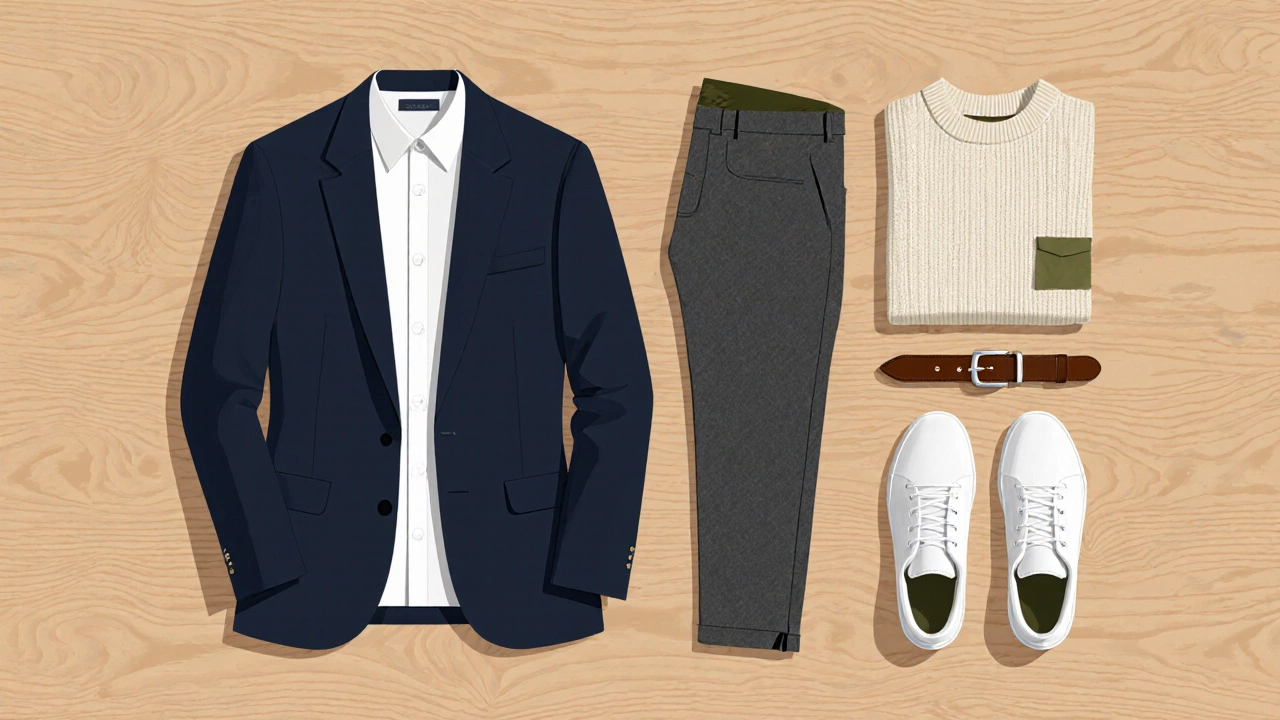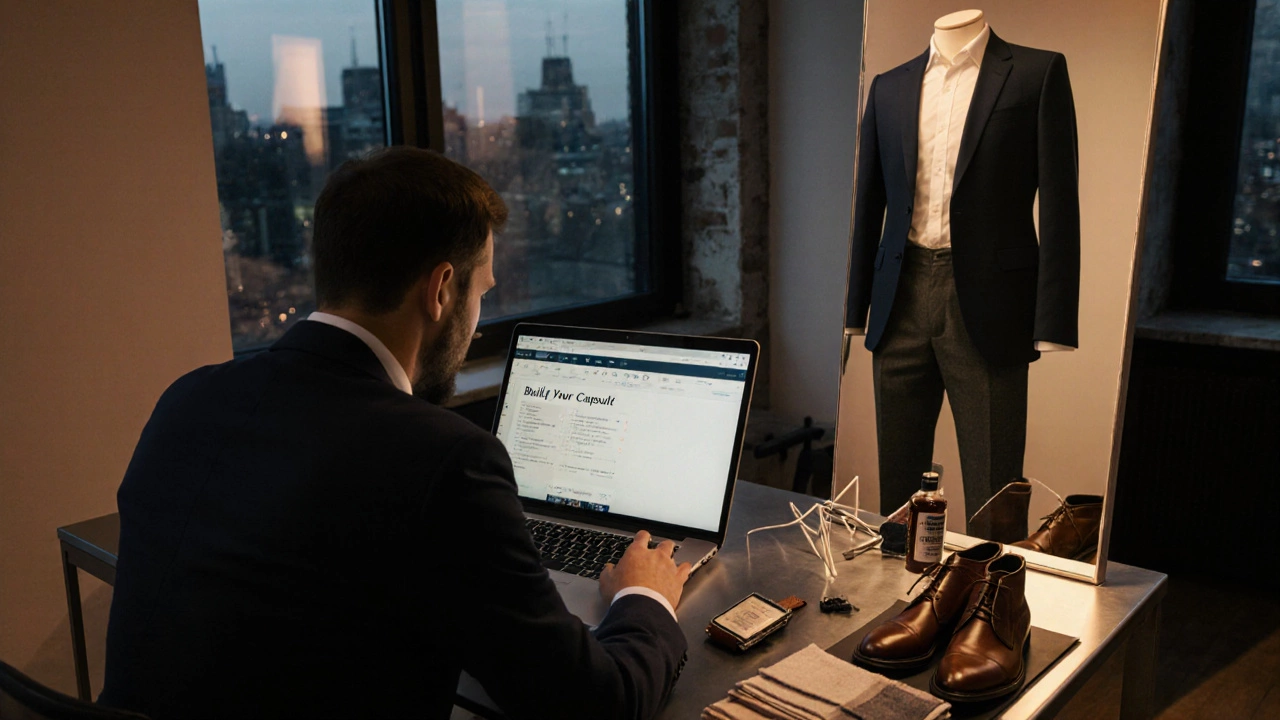Capsule Wardrobe Planner
Your Lifestyle Profile
Help us understand your needs to recommend the best capsule size.
Your Recommended Capsule
Fill in your lifestyle profile and click "Calculate" to see your recommended capsule size.
Color Palette Guide
Effective capsule wardrobes rely on a strategic color approach:
Use a 60-30-10 color ratio: 60% primary neutrals, 30% accent tones, 10% bold statements.
Ever stare at a crowded closet, wonder why you own ten black tees but still feel like you have nothing to wear? A capsule wardrobe solves that dilemma - it’s a small collection of interchangeable pieces that cover every occasion without the clutter.
What a Capsule Wardrobe Actually Is
Capsule wardrobe is a curated set of timeless, versatile clothing items designed to be mixed and matched, keeping the total number of pieces low while covering all seasons and settings. Think of it as a toolbox: the fewer tools you own, the better you know how to use each one. For modern men, the goal is to look sharp, feel confident, and save time and money.
Why Go Minimalist?
- Less decision fatigue - you pick outfits in seconds.
- Higher quality - you invest in pieces that last longer.
- Cleaner aesthetics - a cohesive look feels more put‑together.
- Environmental impact - fewer fast‑fashion purchases means less waste.
Core Building Blocks
Three pillars hold any successful capsule together: color, fabric, and fit.
Neutral Colors
Neutral colors are hues like navy, charcoal, olive, white, and beige that pair effortlessly with each other. Stick to a 60‑30‑10 ratio - 60% primary neutrals, 30% accent tones, 10% bold statements - and you’ll never clash.
Quality Fabrics
Quality fabrics refer to materials such as merino wool, brushed cotton, heavy twill, and premium denim that age well and keep shape. A 180‑gram cotton t‑shirt will feel softer after each wash, while a 100% wool sweater resists odors.
Fit Matters
Fit is the relationship between a garment’s dimensions and your body proportions, ensuring comfort and a flattering silhouette. Tailoring key pieces - a blazer, chinos, or dress shirt - can turn an average look into a polished one without spending more.
Essential Items Checklist
| Category | Core Piece | Optional Add‑On |
|---|---|---|
| Outerwear | Unstructured navy blazer | Lightweight waxed jacket |
| Shirts | Crisp white button‑down | Patterned Oxford shirt |
| Tops | Fine‑knit merino crew | Graphic tee (seasonal) |
| Pants | Charcoal tapered chinos | Dark denim straight leg |
| Shoes | Leather white sneakers | Brown Chelsea boots |
| Accessories | Brown leather belt | Silk pocket square |
Start with the core pieces. Once they feel right, layer on the optional items to reflect personal style or climate.

Seasonal Rotation Made Simple
Modern men often need to transition from a summer meetup to a winter conference. The trick is to keep a base layer of neutrals year‑round and switch out weight and texture.
- Spring/Summer: Light cotton shirts, linen blazer, low‑profile sneakers.
- Fall/Winter: Merino sweaters, wool overcoat, leather boots.
Because each piece is designed to pair with the rest, you only add a few seasonal items - a corduroy jacket for fall or a waterproof trench for rain.
Smart Shopping Strategies
Building a capsule is an investment, not an impulse spree.
- Set a budget. Decide how much you’re willing to spend per core piece. A $150 blazer is a better long‑term buy than a $80 off‑the‑rack version that falls apart.
- Prioritize quality. Look for double‑stitched seams, genuine leather, and natural fibers. These attributes correlate with longevity.
- Buy versatile colors first. Neutral palettes give you the most outfit combinations.
- Try before you buy. Even if you shop online, use generous return policies to ensure fit.
- Consider second‑hand. Vintage stores often carry high‑quality pieces at a fraction of the price.
Maintenance & Care
A capsule only works if you treat it right.
- Garment care involves following label instructions, using gentle cycles, and storing items on proper hangers.
- Repair is the act of fixing small issues - loose seams, missing buttons - before they become major problems.
- Rotation schedule means alternating pieces weekly so no single item wears out too quickly.
Invest in a good shoe tree, a wool dryer ball, and a leather conditioner. Small habits keep your wardrobe looking fresh for years.
Step‑by‑Step: Build Your First Capsule in 30 Days
- Audit your closet. Pull out everything, sort by season, and set aside pieces you love and wear often.
- Identify gaps. Compare your inventory to the core checklist above. List missing items.
- Set a timeline. Allocate one week per category (outerwear, shirts, pants, shoes, accessories).
- Shop strategically. Use the budgeting tips, focus on neutral colors, and prioritize quality.
- Fit and tailor. Bring each new piece to a tailor for minor adjustments - a perfect sleeve length can change the whole look.
- Test combinations. Spend a day mixing and matching. Photograph three‑piece combos you like for future reference.
- Document care. Write a simple care sheet (wash temp, storage method) and stick it on the inside of your closet door.
After a month you’ll have a functional, stylish capsule that reduces morning stress and boosts confidence.
Pro Tips from Style Icons
Men like Steve McQueen, David Beckham, and Timothée Chalamet have all embraced minimalist wardrobes. Notice their common habits:
- They stick to a limited color palette.
- They invest in a well‑fitted blazer.
- They keep shoes polished and rotate them regularly.
Borrow these habits to refine your own capsule.

Frequently Asked Questions
How many items should a men’s capsule wardrobe contain?
A solid starter typically includes 25-30 pieces: 5 tops, 3 bottoms, 2 outer layers, 2 pairs of shoes, and a handful of accessories. Seasonal additions can push the total to around 40.
Can I keep bright colors in a capsule?
Yes, but treat them as accent pieces. A burgundy sweater or olive bomber adds personality without breaking the neutral base.
Is a capsule wardrobe only for formal settings?
No. By selecting versatile cuts-like a slim‑fit tee and smart chinos-you can transition from office to casual brunch with a simple layer swap.
How often should I refresh my capsule?
Review your wardrobe every 6‑12 months. Replace worn items and consider adding a new seasonal piece if your lifestyle or climate changes.
What’s the best way to store shoes in a capsule?
Use shoe trees to maintain shape, keep them in a ventilated shoe rack, and rotate weekly to prevent excessive wear.






